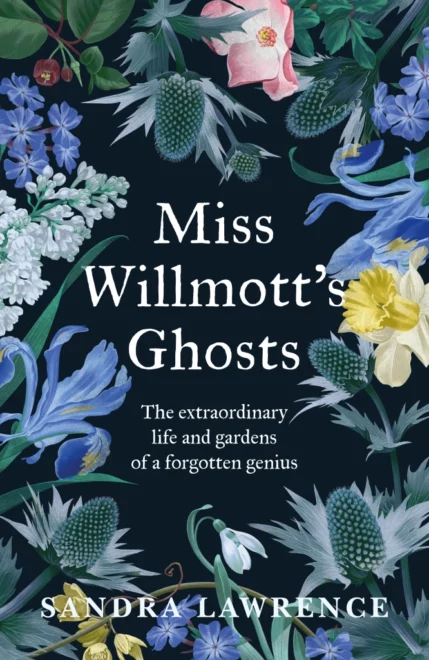Miss Willmott’s Ghosts by Sandra Lawrence, Blink Publishing, 2022
Reviewed by Clare Gleeson
 Who could not be fascinated by the story of Ellen Willmott? An eccentric gardener, with what were seemingly endless resources, she made not one but three magnificent gardens in England, France and Italy before being told she’d spent all her money and had to sell the lot. The Eryngium (Miss Willmott’s Ghost), the seeds of which she was said to sprinkle wherever she visited (and which I have never managed to grow) has become a gardening legend. Ellen has dozens of plant species named after her and Warley Place Nature Reserve, in the ruins of her garden in Essex, turns a golden yellow every spring with the daffodils she planted.
Who could not be fascinated by the story of Ellen Willmott? An eccentric gardener, with what were seemingly endless resources, she made not one but three magnificent gardens in England, France and Italy before being told she’d spent all her money and had to sell the lot. The Eryngium (Miss Willmott’s Ghost), the seeds of which she was said to sprinkle wherever she visited (and which I have never managed to grow) has become a gardening legend. Ellen has dozens of plant species named after her and Warley Place Nature Reserve, in the ruins of her garden in Essex, turns a golden yellow every spring with the daffodils she planted.
But who was the real Ellen Willmott? A spoilt, wealthy botanical genius whose obsession with plants led to her financial ruin, or rather more? Sandra Lawrence’s enjoyable new biography builds on Audrey Le Lievre’s earlier one and shows the reader another side of Ellen, not just as a gardener and botanist, but as a musician, photographer, writer, educator, daughter, sister, friend and possibly lover.
Lawrence’s fondness for her subject is evident throughout and, as I closed the cover, I felt a great deal of goodwill towards poor Ellen and gratitude to Sandra Lawrence. Lawrence has spent hours trawling through not just traditional archives, but trunks and trunks of insect- eaten letters, diaries, photographs and memorabilia stored at Spetchley Park, the home of Ellen’s sister, Rose. The story of Lawrence’s journey of discovery peronalises her fascination with her subject; as a researcher it’s easy to feel her excitement as she turned up yet another “find”. The Spetchley treasure-trove helped answer the question first asked 40 years ago, the question that inspired Lawrence to investigate Ellen’s “ghosts”. Why did Ellen not turn up on 26 October 1897 to be awarded the Victoria Medal of Honour, the highest award of the Royal Horticultural Society? Gertrude Jekyll was there to receive hers that day, but Ellen, the only other woman in the cohort of 63 in the VMH’s inaugural year, was not.
The relics from Bletchley help form the structure of the book. Many chapters begin with an item Lawrence has discovered and which has enabled her to put one more piece of the Ellen Willmott jigsaw in place. Miss Willmott’s Ghosts is littered with interesting snippets about Ellen and her world: that Ellen and her sister, Rose, taught themselves Latin so they could read plant catalogues; that 50 men were employed on the groundwork at Boccanegra, Ellen’s garden in Ventimiglia, Italy; that Ellen owned a copy of Pierre-Joseph Redoubte’s Les Roses; that Ellen’s English gardeners wore a uniform of straw boater with a green band, a knitted green silk tie and a navy-blue apron; that because of her ongoing obstinacy about recognising her financial plight she was reduced to sleeping on a bench in Trafalgar Square on her trips to London.
Lawrence’s discussion of Willmott’s personal relationships showed me the real Ellen. Ellen’s interactions with others were not always positive but she was a devoted sister to Rose and was devastated when Rose died. Ellen could also be a true and loyal friend (too true it seems for the wife of renown narcissi breeder, the Reverend Engleheart). Her letters to Gian Tufnell, a lady-in-waiting to the Duchess of Teck reveal a completely different Ellen and it seems Lawrence is fairly certain that the two women were a couple. It is Ellen’s anguish at the marriage of Gian to a wealthy aristocrat on the day the VMH was to be awarded that Lawrence believes caused Ellen to forgo the event. Of all Miss Willmott’s ghosts, this is the biggest – it shows us an emotional side to Ellen that was missing in past writings. Aside from the detailed description of her horticultural and other achievements I thank Sandra Lawrence for humanising Ellen Willmott and in the process making her even more fascinating than she already was.
https://www.sandralawrence.com/miss-willmotts-ghosts

